.
1.10.2015
NASA’s New Horizons spacecraft has returned the best color and the highest resolution images yet of Pluto’s largest moon, Charon – and these pictures show a surprisingly complex and violent history.
.
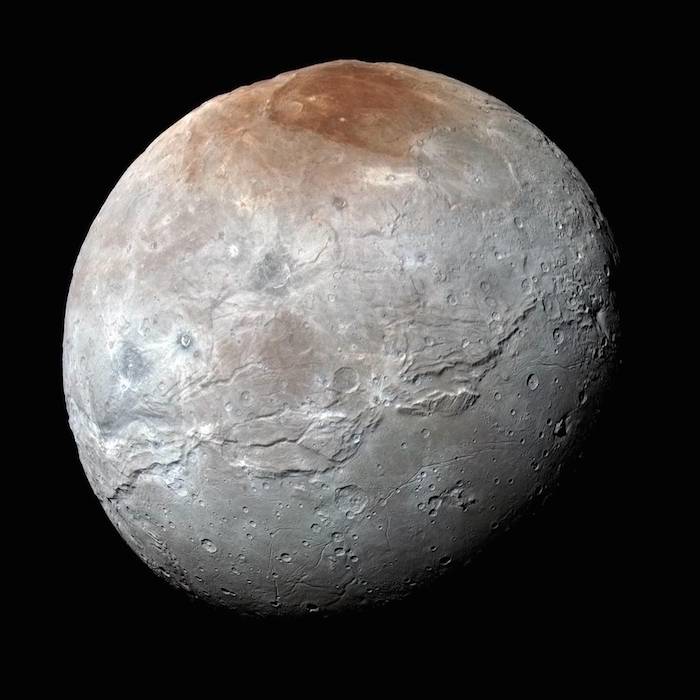
Charon in Enhanced Color NASA's New Horizons captured this high-resolution enhanced color view of Charon just before closest approach on July 14, 2015. The image combines blue, red and infrared images taken by the spacecraft’s Ralph/Multispectral Visual Imaging Camera (MVIC); the colors are processed to best highlight the variation of surface properties across Charon. Charon’s color palette is not as diverse as Pluto’s; most striking is the reddish north (top) polar region, informally named Mordor Macula. Charon is 754 miles (1,214 kilometers) across; this image resolves details as small as 1.8 miles (2.9 kilometers).
Credits: NASA/JHUAPL/SwRI
-
At half the diameter of Pluto, Charon is the largest satellite relative to its planet in the solar system. Many New Horizons scientists expected Charon to be a monotonous, crater-battered world; instead, they’re finding a landscape covered with mountains, canyons, landslides, surface-color variations and more.
“We thought the probability of seeing such interesting features on this satellite of a world at the far edge of our solar system was low,” said Ross Beyer, an affiliate of the New Horizons Geology, Geophysics and Imaging (GGI) team from the SETI Institute and NASA Ames Research Center in Mountain View, California, “but I couldn't be more delighted with what we see."
.
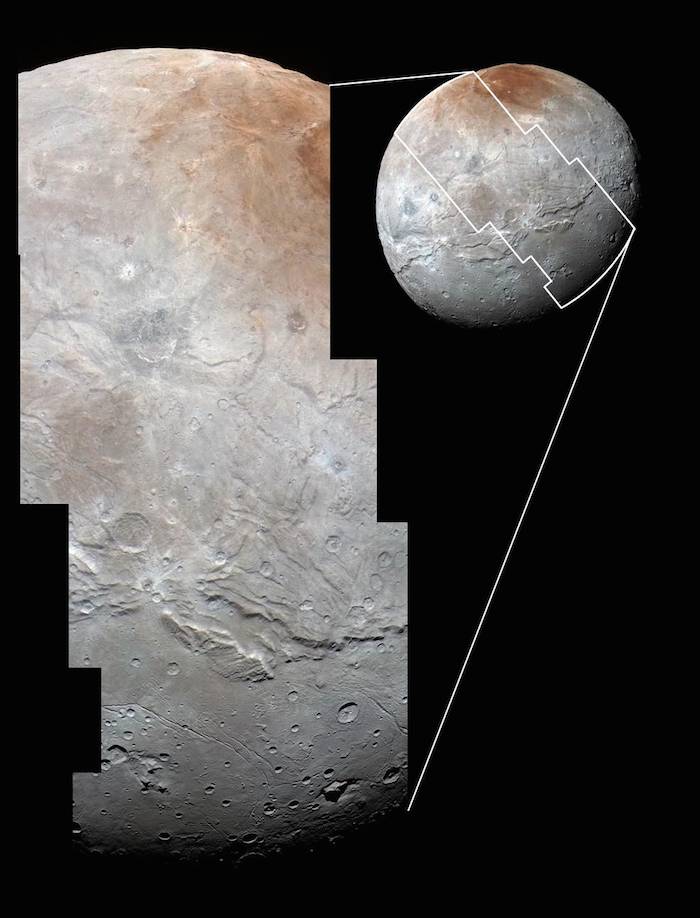
High-resolution images of Charon were taken by the Long Range Reconnaissance Imager on NASA’s New Horizons spacecraft, shortly before closest approach on July 14, 2015, and overlaid with enhanced color from the Ralph/Multispectral Visual Imaging Camera (MVIC). Charon’s cratered uplands at the top are broken by series of canyons, and replaced on the bottom by the rolling plains of the informally named Vulcan Planum. The scene covers Charon’s width of 754 miles (1,214 kilometers) and resolves details as small as 0.5 miles (0.8 kilometers).
Credits: NASA/JHUAPL/SwRI
-
High-resolution images of the Pluto-facing hemisphere of Charon, taken by New Horizons as the spacecraft sped through the Pluto system on July 14 and transmitted to Earth on Sept. 21, reveal details of a belt of fractures and canyons just north of the moon’s equator. This great canyon system stretches more than 1,000 miles (1,600 kilometers) across the entire face of Charon and likely around onto Charon’s far side. Four times as long as the Grand Canyon, and twice as deep in places, these faults and canyons indicate a titanic geological upheaval in Charon’s past.
“It looks like the entire crust of Charon has been split open,” said John Spencer, deputy lead for GGI at the Southwest Research Institute in Boulder, Colorado. “With respect to its size relative to Charon, this feature is much like the vast Valles Marineris canyon system on Mars.”
.
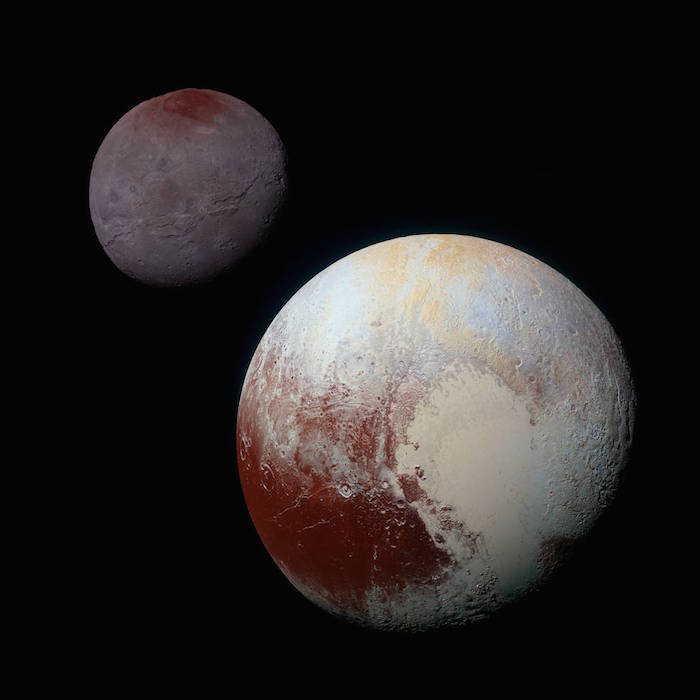
This composite of enhanced color images of Pluto (lower right) and Charon (upper left), was taken by NASA’s New Horizons spacecraft as it passed through the Pluto system on July 14, 2015. This image highlights the striking differences between Pluto and Charon. The color and brightness of both Pluto and Charon have been processed identically to allow direct comparison of their surface properties, and to highlight the similarity between Charon’s polar red terrain and Pluto’s equatorial red terrain. Pluto and Charon are shown with approximately correct relative sizes, but their true separation is not to scale. The image combines blue, red and infrared images taken by the spacecraft’s Ralph/Multispectral Visual Imaging Camera (MVIC).
Credits: NASA/JHUAPL/SwRI
-
The team has also discovered that the plains south of the Charon’s canyon -- informally referred to as Vulcan Planum -- have fewer large craters than the regions to the north, indicating that they are noticeably younger. The smoothness of the plains, as well as their grooves and faint ridges, are clear signs of wide-scale resurfacing.
One possibility for the smooth surface is a kind of cold volcanic activity, called cryovolcanism. “The team is discussing the possibility that an internal water ocean could have frozen long ago, and the resulting volume change could have led to Charon cracking open, allowing water-based lavas to reach the surface at that time,” said Paul Schenk, a New Horizons team member from the Lunar and Planetary Institute in Houston.
Even higher-resolution Charon images and composition data are still to come as New Horizons transmits data, stored on its digital recorders, over the next year – and as that happens, “I predict Charon’s story will become even more amazing!” said mission Project Scientist Hal Weaver, of the Johns Hopkins University Applied Physics Laboratory in Laurel, Maryland.
The New Horizons spacecraft is currently 3.1 billion miles (5 billion kilometers) from Earth, with all systems healthy and operating normally.
New Horizons is part of NASA’s New Frontiers Program, managed by the agency’s Marshall Space Flight Center in Huntsville, Alabama. APL designed, built, and operates the New Horizons spacecraft and manages the mission for NASA’s Science Mission Directorate. SwRI leads the science mission, payload operations, and encounter science planning.
Quelle: NASA
-
Update: 6.10.2015
.
Pluto’s Small Moons Nix and Hydra
This week’s beautiful Charon images remind us that Pluto is not just one body; it’s a whole system of worlds.
Pluto and its largest moon Charon dance around each other, making circles around their common center of mass, which lies in an empty space between them. Around the dancing couple are four small moons. In order of increasing distance, their names are Styx (just beyond Charon), then Nix, Kerberos and Hydra. These tiny moons also orbit around the system’s center of mass. The orbits line up like a miniature solar system, except with a binary system at the center, similar to the planetary system around the star Kepler 47. All four of the small moons are less than about 30 miles (50 kilometers) in their longest dimension. Each has a lumpy shape because, unlike Pluto and Charon, they aren’t big enough for gravity to squish them into a ball.
Nix and Hydra were discovered in 2005, shortly before New Horizons launched in 2006, and their initials were a subtle nod to the New Horizons mission that started the search for them, just as the P and L in Pluto are a subtle nod to astronomer Percival Lowell, who began the search for Pluto.Styx and Kerberos weren’t discovered until 2011 and 2012, well after the New Horizons spacecraft was on its way to Pluto. Although the mission’s observing plans were pretty well set by then, the New Horizons science team anticipated that new discoveries from other facilities might be made during the long cruise to Pluto and had left room for a handful of “TBD” observations, which became the only ones specifically devoted to Kerberos and Styx. That’s why New Horizons took many more pictures of Nix and Hydra than of Styx and Kerberos.
.
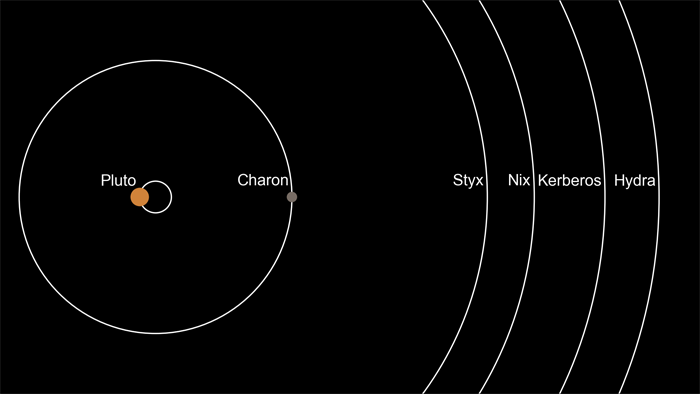
The orbits of Pluto and its moons Charon, Styx, Nix, Kerberos and Hydra are illustrated around their common center of mass. Credit: SwRI/S. Porter
.
Nix is the second-largest of Pluto’s small moons and was the closest to New Horizons during the flyby, so we got better imaging of it than any of the other small moons. So far, we’ve been able to download close-up pictures of Nix taken at three different times by the Long Range Reconnaissance Imager (LORRI) high-resolution camera, but the best image is still on the spacecraft’s digital recorders waiting to come to Earth.
From looking at Nix as point of light with the Hubble Space Telescope and with New Horizons on approach, we knew that Nix’s brightness regularly changed over time, and therefore it was probably elongated. However, the first image (on the left) really surprised us, because Nix appeared to be round—not at all elongated.
Mark Showalter – who discovered Styx and Kerberos — pointed out that we were probably just looking down the long axis, and that the next images would look more “potato-ish.” Sure enough, the next image showed Nix looking far more elongated, but with one great surprise in it: a big crater! Nix isn’t very large, and there is a very fine line between an impact that will make a crater that big and one that will break Nix apart. So either Nix was very lucky in surviving that collision, or it’s a fragment of an older moon that was somehow destroyed.
The last Nix image we have so far was taken right after the spacecraft passed Pluto and started to look back on its crescent. Because Nix has no atmosphere, it isn’t as spectacular as the images looking back at Pluto, but measuring the brightness of that little crescent of light can help tell us about what the surface of Nix is made of, and whether its surface is smooth or covered in boulders.
.
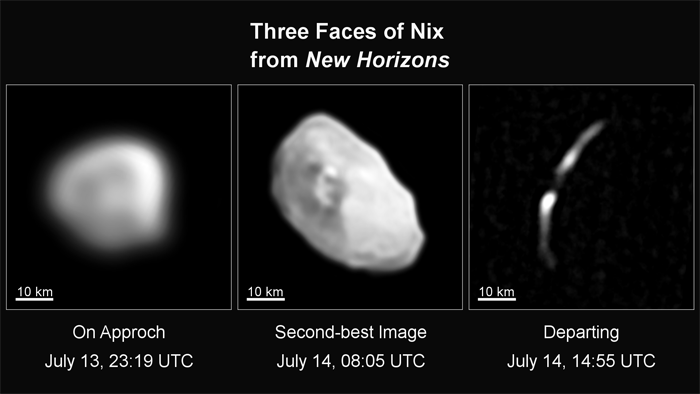
Pluto’s moon Nix is viewed at three different times during the New Horizons July 2015 flyby. Credit: NASA/JHUAPL/SwRI
.
What we do know about the big crater on Nix is that it appears to be a different color than the rest of the moon. The color image below was taken by New Horizons’ Ralph-Multispectral Visible Imaging Camera (MVIC) three minutes before the LORRI picture; MVIC has one-fourth of LORRI’s resolution, but it can see in four colors: blue, red, near-infrared, and methane. In this image, the RGB colors are mapped to near-IR, red and blue, just like the enhanced-color images of Pluto and Charon. While most of Nix is a neutral white, the crater and its ejecta blanket (the material thrown out by the crater) appear to be a much redder material. Craters excavate material from below and throw it on the surface. This tells us that under its white surface, Nix is probably made of much darker material. We don’t actually know what either the dark or the light material is, nor will we be able to tell until we download the Nix data from the Ralph-Linear Etalon Imaging Spectral Array (LEISA) composition mapping spectrometer.
.

Pluto’s moon Nix is shown in high-resolution black-and-white and lower resolution color. Credit: NASA/JHUAPL/SwRI
.
New Horizons also imaged Hydra and has sent some of these images to Earth. Below is the best LORRI image of Hydra taken by New Horizons. Unfortunately, Hydra was on the opposite side of Pluto from New Horizons at closest approach, so the images of Hydra are from farther away and therefore are at lower resolution than the Nix images we have. Because Hydra’s orbit was still somewhat uncertain, the mission planners designed this observation to be a mosaic of six slightly-overlapping shots. As it turns out, we hit the jackpot and Hydra fell right at the intersection of four of those six shots, meaning we got two full and two half-views of Hydra for the price of one!
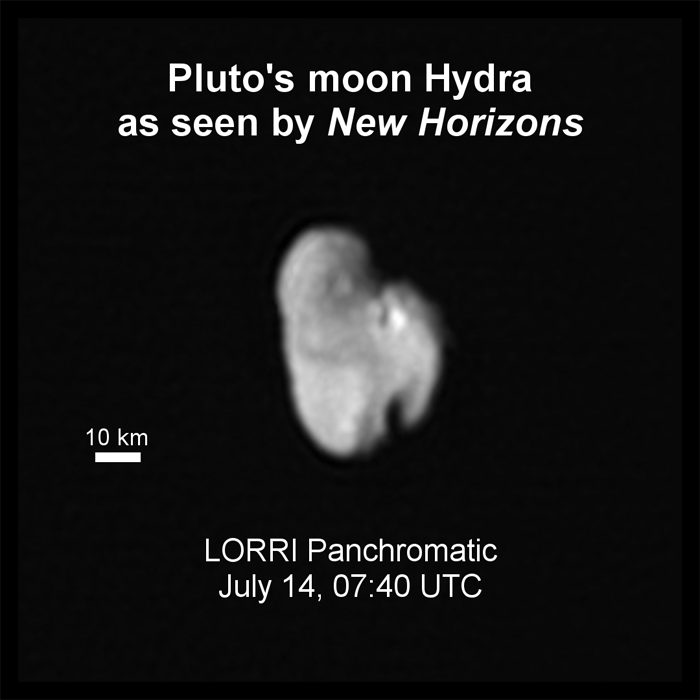
The composite of these images shows that Hydra has a much more complicated shape than Nix and looks a bit like a much bigger version of comet 67P/Churyumov-Gerasimenko, which is currently being orbited by the Rosetta spacecraft. As some have proposed for 67P, it is possible that Hydra is the result of a low-speed collision of two older moons. We haven’t yet had a chance to download the LORRI images of Styx and Kerberos, but they are coming soon, and will be of similar resolution to this image of Hydra.
.

Pluto’s moon Hydra as seen from NASA’s New Horizons spacecraft, July 14, 2015. Credit: NASA/JHUAPL/SwRI
.
Finally, I want to tell you how I processed these images of Nix and Hydra. I created them in Python with AstroPy to read the images and translate from pixels to on-sky coordinates, and Scikit-Image to process and sharpen the images. LORRI’s pixels are smaller than the resolution limit of the imager, which makes the images appear a little bit blurry. But since the optics of LORRI are very stable, we can use a process called “deconvolution” to back out what the image would have been if the camera were perfectly sampled. This makes the images sharper, but also adds “noise.” We can minimize the noise by taking several deconvolved images and finding the median value at each pixel location; this keeps the real detail while throwing out much of the deconvolution noise. Both Astropy and Scikit-Image are free and open sources, and make astronomical image processing fun (and a bit addicting) for anyone with a basic knowledge of Python.
Quelle: NASA
-
Update: 8.10.2015
.
New Horizons Finds Blue Skies and Water Ice on Pluto
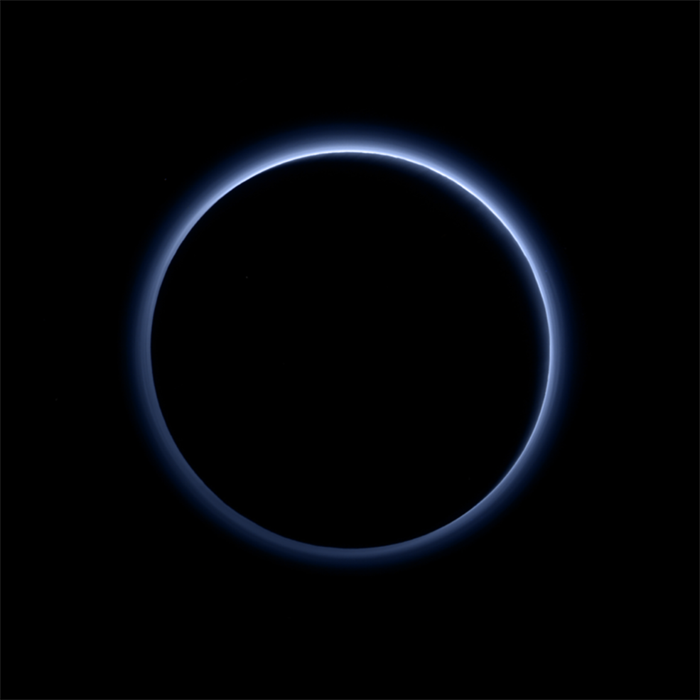
Pluto’s Blue Sky: Pluto’s haze layer shows its blue color in this picture taken by the New Horizons Ralph/Multispectral Visible Imaging Camera (MVIC). The high-altitude haze is thought to be similar in nature to that seen at Saturn’s moon Titan. The source of both hazes likely involves sunlight-initiated chemical reactions of nitrogen and methane, leading to relatively small, soot-like particles (called tholins) that grow as they settle toward the surface. This image was generated by software that combines information from blue, red and near-infrared images to replicate the color a human eye would perceive as closely as possible.
Credits: NASA/JHUAPL/SwRI
-
The first color images of Pluto’s atmospheric hazes, returned by NASA’s New Horizons spacecraft last week, reveal that the hazes are blue.
“Who would have expected a blue sky in the Kuiper Belt? It’s gorgeous,” said Alan Stern, New Horizons principal investigator from Southwest Research Institute (SwRI), Boulder, Colorado.
The haze particles themselves are likely gray or red, but the way they scatter blue light has gotten the attention of the New Horizons science team. “That striking blue tint tells us about the size and composition of the haze particles,” said science team researcher Carly Howett, also of SwRI. “A blue sky often results from scattering of sunlight by very small particles. On Earth, those particles are very tiny nitrogen molecules. On Pluto they appear to be larger — but still relatively small — soot-like particles we call tholins.”
Scientists believe the tholin particles form high in the atmosphere, where ultraviolet sunlight breaks apart and ionizes nitrogen and methane molecules and allows them to react with one another to form more and more complex negatively and positively charged ions. When they recombine, they form very complex macromolecules, a process first found to occur in the upper atmosphere of Saturn’s moon Titan. The more complex molecules continue to combine and grow until they become small particles; volatile gases condense and coat their surfaces with ice frost before they have time to fall through the atmosphere to the surface, where they add to Pluto’s red coloring.
In a second significant finding, New Horizons has detected numerous small, exposed regions of water ice on Pluto. The discovery was made from data collected by the Ralph spectral composition mapper on New Horizons.
.
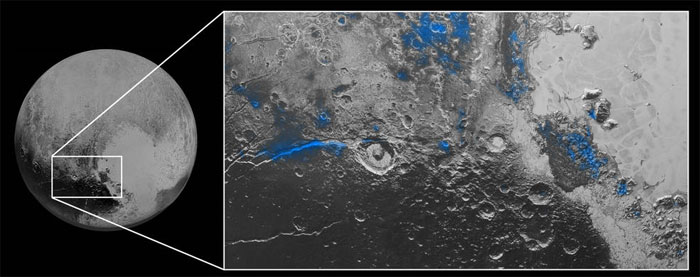
Water Ice on Pluto: Regions with exposed water ice are highlighted in blue in this composite image from New Horizons' Ralph instrument, combining visible imagery from the Multispectral Visible Imaging Camera (MVIC) with infrared spectroscopy from the Linear Etalon Imaging Spectral Array (LEISA). The strongest signatures of water ice occur along Virgil Fossa, just west of Elliot crater on the left side of the inset image, and also in Viking Terra near the top of the frame. A major outcrop also occurs in Baré Montes towards the right of the image, along with numerous much smaller outcrops, mostly associated with impact craters and valleys between mountains. The scene is approximately 280 miles (450 kilometers) across. Note that all surface feature names are informal.
Credits: NASA/JHUAPL/SwRI
-
“Large expanses of Pluto don’t show exposed water ice,” said science team member Jason Cook, of SwRI, “because it’s apparently masked by other, more volatile ices across most of the planet. Understanding why water appears exactly where it does, and not in other places, is a challenge that we are digging into.”
A curious aspect of the detection is that the areas showing the most obvious water ice spectral signatures correspond to areas that are bright red in recently released color images. “I’m surprised that this water ice is so red,” says Silvia Protopapa, a science team member from the University of Maryland, College Park. “We don’t yet understand the relationship between water ice and the reddish tholin colorants on Pluto's surface.”
The New Horizons spacecraft is currently 3.1 billion miles (5 billion kilometers) from Earth, with all systems healthy and operating normally.
Quelle: NASA
.
Update: 16.10.2015
.
New Horizons Team Publishes First Research Paper in Science, Describing Numerous Pluto System Findings
From Pluto’s unusual heart-shaped region to its extended atmosphere and intriguing moons, New Horizons has revealed a degree of diversity and complexity in the Pluto system that few expected in the frigid outer reaches of the solar system.
The New Horizons team describes a wide range of findings about the Pluto system in its first science paper, released today. “The Pluto System: Initial Results from its Exploration by New Horizons,” led by mission Principal Investigator Alan Stern, appears as the cover story in the Oct. 16 issue of Science, just three months after NASA’s historic first exploration of the Pluto system in July.
“The New Horizons mission completes our initial reconnaissance of the solar system, giving humanity our first look at this fascinating world and its system of moons,” said Jim Green, director of planetary science at NASA Headquarters in Washington. “New Horizons is not only writing the textbook on the Pluto system, it’s serving to inspire current and future generations to keep exploring — to keep searching for what’s beyond the next hill.”
NASA’s New Horizons spacecraft reached a distance of 7,750 miles (12,500 kilometers) from Pluto’s surface during its July 14 closest approach, gathering so much data it will take almost another year to return to Earth. The data returned so far show a surprisingly wide variety of landforms and terrain ages on Pluto, as well as variations in color, composition and albedo (surface reflectivity). Team members also discovered evidence for a water-ice rich crust, multiple haze layers above the surface in Pluto’s atmosphere, and that Pluto is somewhat larger and a bit more ice rich than expected.
“The Pluto system surprised us in many ways, most notably teaching us that small planets can remain active billions of years after their formation,” said Stern, with the Southwest Research Institute (SwRI) in Boulder, Colorado. “We were also taught important lessons by the degree of geological complexity that both Pluto and its large moon Charon display.”
Some of the processes on Pluto appear to have occurred geologically recently, including those that involve the water-ice rich bedrock as well as the more volatile, and presumably more mobile, ices of the western lobe of Pluto’s “heart.” The diverse geology and apparent recent activity raise fundamental questions about how small planetary bodies remain active many billions of years after formation. The research suggests that other large worlds in the Kuiper belt — such as Eris, Makemake and Haumea — could also have similarly complex histories that rival those of terrestrial planets such as Mars and Earth.
The New Horizons team notes that Triton, likely a former Kuiper Belt planet captured by Neptune, was considered the best analog for Pluto prior to the July 14 flyby. The team now believes that the geologies of Triton and Pluto are more different than similar, but will know more as additional data are returned.
New Horizons is part of NASA’s New Frontiers Program, managed by the agency’s Marshall Space Flight Center in Huntsville, Alabama. The Johns Hopkins University Applied Physics Laboratory, Laurel, Maryland, designed, built and operates the New Horizons spacecraft and manages the mission for NASA’s Science Mission Directorate. SwRI leads the science mission, payload operations and encounter science planning.
Quelle: The Johns Hopkins University
---
New Horizons reveals Pluto's striking surface variations and unique moon rotations
UMD astronomers contribute to first published results from Pluto flyby
UNIVERSITY OF MARYLAND
University of Maryland astronomers Silvia Protopapa and Douglas Hamilton are among the authors of the first published paper from the New Horizons flyby, which appears in the Oct. 16, 2015 issue of the journal Science. Protopapa helped map the composition of Pluto's surface and locate ices on it. Hamilton helped confirm the shapes, sizes and unique rotations of two of Pluto's moons and the finding that no other moons appear to orbit Pluto. The findings will help scientists understand the origins and subsequent history of Pluto and its moons.
The color image of Pluto published in the Science paper and obtained with the spacecraft's Multi-spectral Visible Imaging Camera (MVIC) reveals a wide range of colors across Pluto's surface--from dark, red regions at the equator to brighter, bluer regions at higher latitudes. A heart-shaped region interrupts this pattern by displaying different colors in its western and eastern lobes.
"We knew Pluto's surface was heterogeneous based on ground-based data. However, I was astonished to see such spectacular surface color and geological diversity," said Protopapa, an assistant research scientist in astronomy at UMD who joined the New Horizons surface composition team led by Will Grundy of the Lowell Observatory a year before closest approach. In previous work, Protopapa used ground-based spectroscopic measurements and sophisticated modeling to determine the surface composition of Pluto and one of its moons, Charon. She also conducted laboratory experiments to establish the spectral behavior of mixtures containing various ratios of methane and nitrogen at different temperatures, which will help her interpret the New Horizons data.
To explore whether Pluto's color diversity is due to its composition, Protopapa and her colleagues analyzed data from the spacecraft's Linear Etalon Imaging Spectral Array (LEISA). LEISA is a near-infrared spectral imager designed to map the surface composition of Pluto and its moons. Methane, carbon monoxide, nitrogen and water ices, and other materials including organic compounds absorb light at different near-infrared wavelengths, allowing the compounds to be detected using the LEISA spectrometer.
In the Science paper, the team reports significant regional differences in volatile ices on Pluto's surface. The western lobe of the heart-shaped region contains methane ice and carbon monoxide ice, while the dark red equatorial regions appear to contain very little volatile ice.
LEISA data released by NASA but not included in the Science paper reveals numerous small exposed regions of water ice in the red areas of the color images taken by the MVIC. This data offers the first clear evidence of water ice on Pluto, following decades of trying to detect it using Earth-based telescopes.
"Water ice is a new element that we must consider as we try to piece together Pluto's complex surface composition," said Protopapa.
The red color on the surface indicates the presence of organic compounds called tholins, which are the result of energetic irradiation of methane, nitrogen and carbon monoxide mixtures. However, Protopapa and her colleagues do not yet understand the relationship between water ice and tholins on Pluto's surface. Why water ice appears where it does and not elsewhere, and which types of tholins are present on Pluto's surface are questions Protopapa and the New Horizons surface composition team hope to answer . The team also plans to compare the New Horizons mission data with ground-based measurements taken at different seasons during Pluto's orbit to obtain a more complete picture of the complex mechanisms that shape Pluto's surface.
Pluto isn't alone in having water ice on its surface--measurements indicate that Nix and Hydra, two of Pluto's five moons, are also covered with water ice. However, the bright surfaces of the two moons surprise astronomers because a variety of external processes should have darkened the surfaces of these moons over time. The rotational patterns of Pluto's moons also puzzle astronomers, as the two moons do not always have the same face locked toward Pluto.
"We knew Nix and Hydra were slowly tumbling in unpredictable ways, based on ground-based findings we published earlier this summer in Nature. With New Horizons data, we now believe Nix and Hydra are spinning really fast and rotating in an odd way, and may be the only regular moons, meaning satellites that are near their host planets, which do not always point the same face toward their primary body," said Hamilton, an astronomy professor at UMD who discovered Pluto's moon Kerberos in 2011 with Mark Showalter of the SETI Institute.
According to Hamilton, the strange rotation patterns of these two moons could be due to the system's domination by Pluto and its largest moon, Charon, which together form a "binary planet."
"It's possible that Nix and Hydra can't focus on locking one face toward Pluto because Charon keeps sweeping past and stirring things up," said Hamilton.
Data published in the Science paper confirms ground-based measurements detailing the similar sizes and shapes of Nix (30 miles by 20 miles) and Hydra (27 miles by 20 miles). The surface compositions of the moons also appear similar--Hydra boasts several crater-like features, and Nix sports a large crater that appears to be a different color than the rest of the moon. The New Horizons team expects to learn more about the surface composition of the moons when they download additional LEISA data.
Something the team won't need to do is analyze new moons.
"Based on the data, we can confidently say that between Pluto and its outermost moon Hydra there are no new icy objects with a diameter larger than 1.5 kilometers (0.9 miles), which is about five times smaller than Pluto's smallest known moon Styx," said Hamilton.
During the approach to Pluto, Hamilton helped ensure that the New Horizons spacecraft would not encounter nor crash into any previously undiscovered moons, rings or debris as it approached and passed by Pluto. Hamilton was part of a 10-person team that spent more than a year streamlining its image analysis process before closest approach. If team members identified a possible moon or debris in an image and fit an orbit to the object, Hamilton used the University of Maryland's new Deepthought2 supercomputer to predict how much debris might be released from the object and hit the spacecraft as it traveled through five possible trajectories. Other team members used this information to predict spacecraft survival.
"We practiced and trained so hard, but when we analyzed images from the New Horizons spacecraft during its approach, we didn't find any new moons, rings or debris orbiting Pluto," said Hamilton.
###
In addition to Protopapa and Hamilton, UMD alumnus Matthew Hill (M.S. '98, Ph.D. '01, physics) was also a co-author on the Science paper.
This research was supported by NASA's New Horizons project. The content of this article does not necessarily reflect the views of this organization.
Quelle: AAAS
---
Update: 18.10.2015
.
Pluto’s Puzzling Patterns and Pits
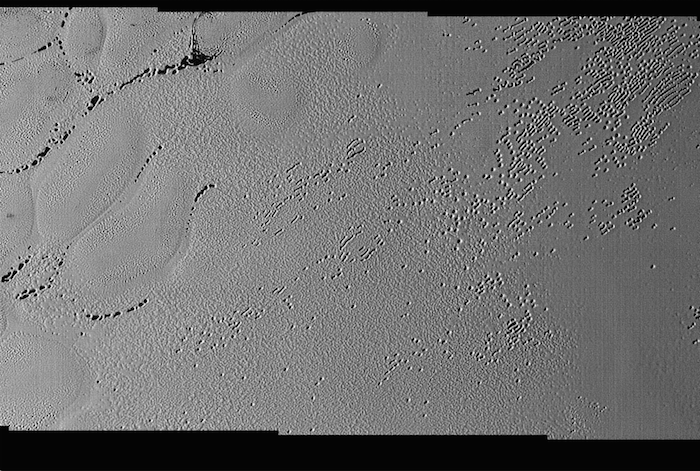
This image was taken by the Long Range Reconnaissance Imager (LORRI) on NASA's New Horizons spacecraft shortly before closest approach to Pluto on July 14, 2015; it resolves details as small as 270 yards (250 meters). The scene shown is about 130 miles (210 kilometers) across. The sun illuminates the scene from the left, and north is to the upper left.
Credits: NASA/JHUAPL/SwRI
-
It seems that the more we see of Pluto, the more fascinating it gets. With its prominent heart-shaped feature, icy mountains, and “snakeskin” terrain, Pluto has already surprised New Horizons scientists with the variety and complexity of its surface features.
Now this latest image, from the heart of Pluto’s heart feature, show the plains’ enigmatic cellular pattern (at left) as well as unusual clusters of small pits and troughs (from lower left to upper right).
Scientists believe that this area, informally known as Sputnik Planum, is composed of volatile ices such as solid nitrogen. They theorize that the pits and troughs – typically hundreds of meters across and tens of meters deep – are possibly formed by sublimation or evaporation of these ices. However, the reasons for the striking shapes and alignments of these features are a mystery. Adding to the intrigue is that even at this resolution, no impact craters are seen, testifying to the extreme geologic youth of Sputnik Planum.
“Pluto is weird, in a good way,” said Hal Weaver, New Horizons project scientist with Johns Hopkins Applied Physics Laboratory in Laurel, Maryland. “The pits, and the way they’re aligned, provide clues about the ice flow and the exchange of volatiles between the surface and atmosphere, and the science team is working hard to understand what physical processes are at play here.”
-
From Pluto’s unusual heart-shaped region to its extended atmosphere and intriguing moons, New Horizons has revealed a degree of diversity and complexity in the Pluto system that few expected in the frigid outer reaches of the solar system.
.
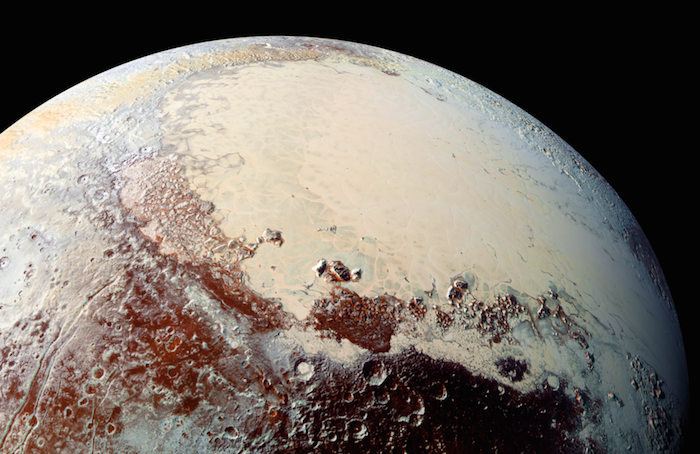
This high-resolution image captured by NASA’s New Horizons spacecraft combines blue, red and infrared images taken by the Ralph/Multispectral Visual Imaging Camera (MVIC). The bright expanse is the western lobe of the “heart,” informally called Sputnik Planum, which has been found to be rich in nitrogen, carbon monoxide and methane ices.
Credits: NASA/JHUAPL/SwRI
The New Horizons team describes a wide range of findings about the Pluto system in its first science paper, released today. “The Pluto System: Initial Results from its Exploration by New Horizons,” led by mission Principal Investigator Alan Stern, appears as the cover story in the Oct. 16 issue of Science, just three months after NASA’s historic first exploration of the Pluto system in July.
“The New Horizons mission completes our initial reconnaissance of the solar system, giving humanity our first look at this fascinating world and its system of moons,” said Jim Green, director of planetary science at NASA Headquarters in Washington. “New Horizons is not only writing the textbook on the Pluto system, it’s serving to inspire current and future generations to keep exploring—to keep searching for what’s beyond the next hill.”
NASA’s New Horizons spacecraft reached a distance of 7,750 miles (12,500 kilometers) from Pluto’s surface during its July 14 closest approach, gathering so much data it will take almost another year to return to Earth. The data returned so far show a surprisingly wide variety of landforms and terrain ages on Pluto, as well as variations in color, composition and albedo (surface reflectivity). Team members also discovered evidence for a water-ice rich crust, multiple haze layers above the surface in Pluto’s atmosphere, and that Pluto is somewhat larger and a bit more ice rich than expected.
“The Pluto system surprised us in many ways, most notably teaching us that small planets can remain active billions of years after their formation,” said Stern, with the Southwest Research Institute (SwRI) in Boulder, Colorado. “We were also taught important lessons by the degree of geological complexity that both Pluto and its large moon Charon display.”
Some of the processes on Pluto appear to have occurred geologically recently, including those that involve the water-ice rich bedrock as well as the more volatile, and presumably more mobile, ices of the western lobe of Pluto’s “heart.” The diverse geology and apparent recent activity raise fundamental questions about how small planetary bodies remain active many billions of years after formation. The research suggests that other large worlds in the Kuiper belt -- such as Eris, Makemake, and Haumea -- could also have similarly complex histories that rival those of terrestrial planets such as Mars and Earth.
The New Horizons team notes that Triton, likely a former Kuiper Belt planet captured by Neptune, was considered the best analog for Pluto prior to the July 14 flyby. The team now believes that the geologies of Triton and Pluto are more different than similar, but will know more as additional data are returned.
New Horizons is part of NASA’s New Frontiers Program, managed by the agency’s Marshall Space Flight Center in Huntsville, Alabama. The Johns Hopkins University Applied Physics Laboratory, Laurel, Maryland, designed, built, and operates the New Horizons spacecraft and manages the mission for NASA’s Science Mission Directorate. SwRI leads the science mission, payload operations, and encounter science planning.
.
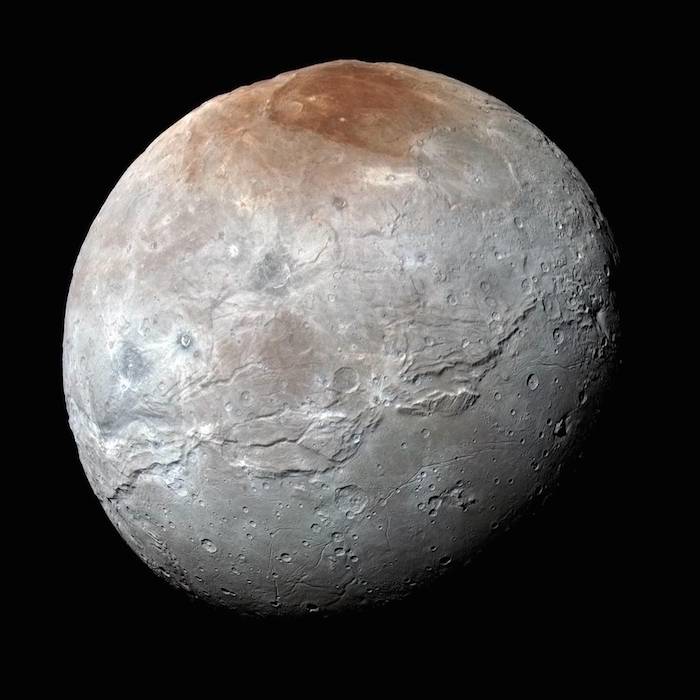
NASA’s New Horizons captured this high-resolution enhanced color view of Charon just before closest approach on July 14, 2015.
Credits: NASA/JHUAPL/SwRI
.
Quelle: NASA
4665 Views
